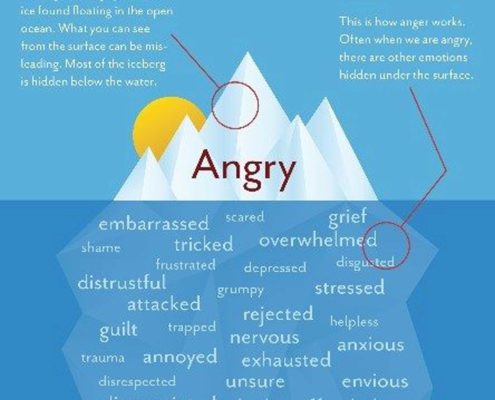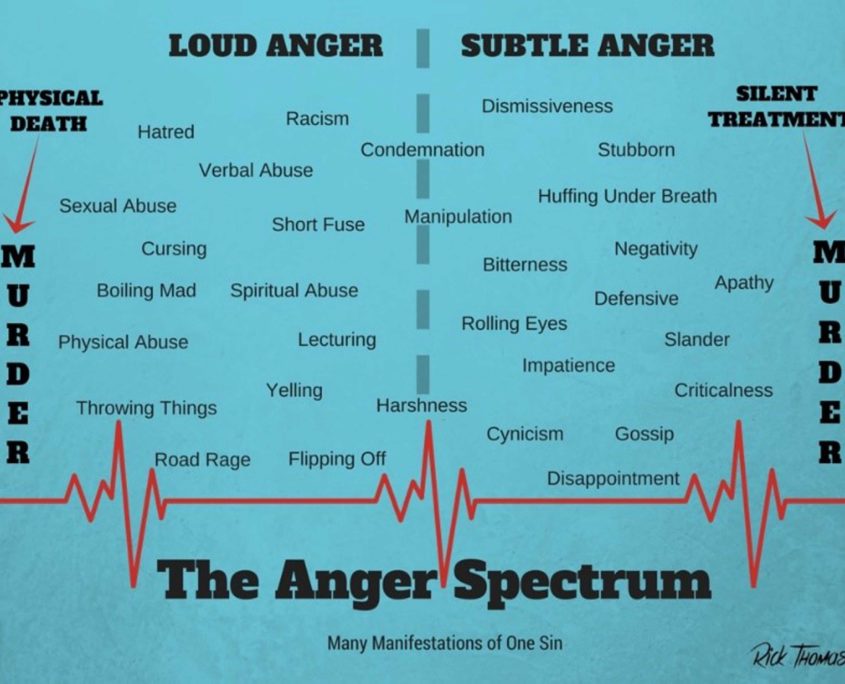We all make associations with the word anger—such as irritated, disrespectful, aggressive, or upset. Let’s discuss the meaning of anger and some of its most common forms.
Anger Issues: Symptoms
These are some of the most common types of anger issues symptoms. Each form of anger is complex, but it can be treatable in a counseling setting.
1. Silent / Invisible anger
You might be familiar with this type of anger with someone in your life. You can tell they’re upset, but they don’t verbally express their feelings. Anger isn’t always an obvious or aggressive emotion. Most or all people sometimes experience unseen anger that remains internal and can’t necessarily be discerned by others, at least not right away.
 You’ve probably heard the phrase, “It made my blood boil.” This is a very apt description of internal anger. It runs hot within your veins, yet other people might not even know it’s there. Silent anger often starts with emotions building up little by little.
You’ve probably heard the phrase, “It made my blood boil.” This is a very apt description of internal anger. It runs hot within your veins, yet other people might not even know it’s there. Silent anger often starts with emotions building up little by little.
When I work with clients who’ve experienced trauma or bullying in the past, I keep an eye out for symptoms of anger, because this is a normal human response. When you are humiliated, neglected, or abused, your anger is justified.
Having your dignity or rights taken from you will cause you to feel a sense of righteous anger that will manifest itself in some way. This can also become unhealthy anger, but at first, I simply seek to determine where any hidden anger is and who or what it’s directed at.
In sessions, I use a Rubik’s Cube and ask my client to hide it somewhere in the room. I’m going to watch where they hide it, but they should still put it somewhere out of sight.
Once they’ve placed it behind a plant or under the couch, etc., I use it as an example by saying, “So the anger cube isn’t in the room anymore because I can’t see it, right? If we can’t see it, it’s not there.”
Whether the client quickly figures out the example or not, it eventually leads to a discussion about how anger still exists even if it’s hidden or layered underneath other emotions.
Then I use the Rubik’s Cube to ask the client what they notice first. Maybe it’s a shape or a color. We discuss how the cube is one entity made out of numerous parts; e.g., it’s a square and it’s also many squares.
Just like the Rubik’s Cube, anger is one emotion, but it’s also the composite of other emotions. It’s never as simple as just being angry. This leads to exploring the question of any hidden anger a client might be holding inside of them.
The anger eventually surfaces; it may be towards a specific person or maybe about a particular time, place, or event. But in the case of silent anger, it simply hasn’t been verbalized. That’s why it’s so important to understand the next truth about anger:
Anger is always expressed in some way; if not through words, then through something else.
And what form does the expression of silent anger usually take? The answer is aggression.
2. Aggressive anger
 When we think of anger, we often immediately think of aggression because it’s a noticeable expression of emotion. It can be frightening to the angry person and those around them.
When we think of anger, we often immediately think of aggression because it’s a noticeable expression of emotion. It can be frightening to the angry person and those around them.
It can involve screaming, yelling, slamming, stomping, and even hitting, kicking, punching, and throwing. This type of anger can be accompanied by a surge of adrenaline, which can have very harmful effects when not channeled properly.
And again, we have to remember that anger is going to surface somehow. If it’s not talked about, it will be expressed in some other way. This is why therapy examines the root causes of anger in each individual.
From a personal standpoint, my own anger has usually stemmed from other negative emotions I was experiencing at the time, such as shame, loneliness, sadness, hurt, etc.
When one or more of these negative emotions feel overwhelming, anger can take hold, especially if some other crisis or disappointment is added on top of it. Suddenly, the emotions we’ve been internalizing for weeks or months all come out at once.
We can compare anger to a balloon that’s slowly being inflated. Eventually, if you don’t stop inflating it, that balloon is going to pop!
Another word picture for anger is that of an iceberg. We can visibly see the part of the iceberg that’s looming above the surface, but what’s underneath is massive in comparison. The hidden portion makes up the majority of the iceberg itself.
The Gottman Institute has described anger as an iceberg. Here is their diagram:

The problem is that it’s easy to ignore those feelings under the surface until they become unnoticeable in the form of anger. There’s a sort of calm before the storm that can give us a false sense of security. Suddenly the aggression comes out, and we’re shocked and completely caught off guard because we didn’t identify the hidden emotions.
The difference between silent and aggressive anger can also be described as the difference between covert and overt or loud and subtle anger:

This diagram specifically names silent treatment as a form of anger. It’s important to identify actions like this as stemming from anger because they’re incredibly hurtful to others.
Stonewalling can feel like being murdered at times. However, it’s possible for overt anger to lead to actual murder. Either way, anger can become brutal and destructive if it is not addressed.
If you’re struggling to figure out how serious someone’s anger is, consider the analogy of a ladder:
Anger can be silent when it begins. But if it’s not dealt with, it can progress up the ladder three or four rungs and turn into overtly shaming or blaming another person. This means it’s important to address anger even if it’s not causing outbursts yet.
That’s why it’s so important to think carefully about the possibility of hidden anger. Being able to discuss the root issues in a safe environment is the first step towards learning to process anger calmly and appropriately.
During a therapeutic session, a counselor might ask a client to replace the word anger with another emotion to describe how they’re feeling. They may also study particular situations where their anger was triggered, attempting to lift the layers to find out what’s underneath the outward behavior.
 This process of verbalizing the memory of anger and its associated feelings is a way of integrating the brain’s two hemispheres. One hemisphere is emotional (the right brain) and one is logical (the left brain). Voicing the often wordless feelings associated with anger is the first step towards gaining control over it.
This process of verbalizing the memory of anger and its associated feelings is a way of integrating the brain’s two hemispheres. One hemisphere is emotional (the right brain) and one is logical (the left brain). Voicing the often wordless feelings associated with anger is the first step towards gaining control over it.
The process of verbalizing what’s underneath anger can become a healthy outlet for those feelings, making harmful expressions of anger unnecessary. And talking about anger out loud suddenly makes it seem much less powerful. Addressing feelings constructively makes them seem easier to handle.
If you are on the receiving end of someone’s outburst of anger, you might feel helpless and scared, or it may trigger your own anger. Either way, there’s a fixation on the other person’s anger. If you feel threatened, your body goes into “fight or flight” mode. The situation might seem volatile and you don’t know what’s going to happen next.
Learning to understand anger in its most basic form can help it seem less volatile. It’s actually quite predictable. This can remove some of the power the angry person might seem to have over you.
Anger is a combined response to specific emotions, life circumstances, and chemicals in the brain and body. This is not to oversimplify a complex issue, but the reality is that anger isn’t that different in a five-year-old vs. a hardened criminal. It’s just the expression and degree that’s different. It’s so important to examine the anger outside of the outbursts themselves.
Whether we’re talking to a child, a criminal, or someone in between, we can ask the same questions. “What do you remember?” “When did you start to feel the anger physically?” “What was the next thing that happened?”
In that sense, each buildup of anger and outburst tells a similar story. If we take an objective look at the situation, we’ll be able to see the tension building and the factors that contributed to the story reaching its climax.
3. Self-focused vs. others-focused anger
One last important form of anger involves the issue of anger at oneself vs. anger at others. This type of anger is often associated with depression. Working through the thought processes behind depression often uncovers deep-rooted, self-directed anger.
 It might not seem like such a big deal to have low self-esteem or struggle with demeaning self-talk (like “I hate myself,” “I’m a failure,” etc.), but this can easily spiral into constant feelings of worthlessness.
It might not seem like such a big deal to have low self-esteem or struggle with demeaning self-talk (like “I hate myself,” “I’m a failure,” etc.), but this can easily spiral into constant feelings of worthlessness.
Failure to address this can eventually lead to suicidal ideations or attempts, the ultimate act of self-hatred. This self-hatred is really self-directed anger that has grown to such a point that the individual feels unworthy of life.
Murder is the opposite of suicide. Anger towards another person grows to such an extent that taking their life seems to be a justifiable action.
Both murder and suicide point to anger that has grown out of control. Before it gets to that point, it’s crucial to examine where it’s coming from and what possible solutions are.
Anger Issues Symptoms: Hope for Overcoming Them
Even though it can seem impossible for an angry person to change, the truth is that anger problems are treatable.
The emotion of anger itself is not necessarily wrong. It’s possible to be angry for valid reasons. This is known as righteous anger, and it means anger at something that is unjust, whether towards yourself or someone else.
Anger signals that something is wrong somewhere. The problem is when it is the result of sin within our own hearts (such as pride) or when it is channeled in harmful thoughts, words, and behaviors.
Any anger, even righteous anger, can become a flame that burns out of control. There are many Bible passages that address anger, because it is one of the most common and powerful human emotions, and it can be so difficult to control. Here are just a few of the many passages that address anger:
Be angry and yet do not sin; do not let the sun go down on your anger. – Ephesians 4:26-27
My dear brothers and sisters, take note of this: Everyone should be quick to listen, slow to speak and slow to become angry because human anger does not produce the righteousness that God desires. – James 1:19-20
A man’s discretion makes him slow to anger, and it is his glory to overlook a transgression. – Proverbs 19:11
“Angry Adult”, Courtesy of Pixabay.com, CC0 License; “Scream,” courtesy of Jason Rosewell, unsplash.com, CC0 License; “The Ultimate Athlete”, Courtesy of Autumn Goodman, Unsplash.com; CC0 License; “Plastic Face”, Courtesy of Splitshire, Splitshire.com, CC0 License


